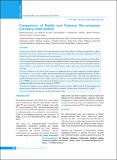Please use this identifier to cite or link to this item:
https://hdl.handle.net/20.500.14356/1252| Title: | Comparison of Radial and Femoral Percutaneous Coronary Intervention |
| Authors: | Bhattarai, Mahesh Maskey, Arun Shah, Ram Kishore Bhandari, Buna Adhikari, Chandramani Tamrakar, Rikesh Pandey, Rabindra Nepal, Himanshu |
| Citation: | BhattaraiM., MaskeyA., ShahR. K., BhandariB., AdhikariC., TamrakarR., PandeyR., & NepalH. (2020). Comparison of Radial and Femoral Percutaneous Coronary Intervention. Journal of Nepal Health Research Council, 18(3), 366-372. https://doi.org/10.33314/jnhrc.v18i3.2587 |
| Issue Date: | 2020 |
| Publisher: | Nepal Health Research Council |
| Article Type: | Original Article |
| Keywords: | Femoral Percutaneous coronary intervention Radial |
| Series/Report no.: | Jul-Sep 2020;2587 |
| Abstract: | Abstract Background: The use of radial access for percutaneous coronary intervention is increasing in Nepal. However, there is limited study on the comparison of radial and femoral access in Nepal. This is the study comparing net adverse clinical events of radial with femoral access for intervention. Methods: This prospective study was conducted at Shahid Gangalal National Heart Center from January 2014 to June 2015 among 849 participations who underwent percutaneous coronary interventions, and 418 radial interventions were compared with 418 femoral interventions. A comparison was done in terms of 30- day rate of net adverse clinical events defined as the composite of death, myocardial infarction, stroke, target lesion revascularization and major bleeding. Results: Incidence of net adverse clinical events was significantly lower in radial compared to femoral approach 18(4.30%) vs. 51 (12.2%), p= <0.001). Mortality observed in the radial approach was significantly lower (p=<0.001) compared to femoral. Procedure success was not significantly different p=0.629. The trans-radial approach had significantly higher crossover rate (p=0.001). Observed vascular access site complications (p=0.026) and hospital stay (p=<0.0001) were lower in the radial group. Radiation exposure measured by fluoroscopy exposure time was not significantly different between the two groups (p=0.290). Conclusions: Radial access is associated with a lower rate of net adverse clinical events at 30 days compared to femoral access. Radial access is safer and equally effective compared to femoral access in the context of Nepal. Keywords: Femoral; percutaneous coronary intervention; radial |
| Description: | Original Article |
| URI: | http://103.69.126.140:8080/handle/20.500.14356/1252 |
| ISSN: | JNHRC Print ISSN: 1727-5482; Online ISSN: 1999-6217 |
| Appears in Collections: | Vol. 18 No. 3 (2020): Vol. 18 No. 3 Issue 48 Jul-Sep 2020 |
Files in This Item:
| File | Description | Size | Format | |
|---|---|---|---|---|
| 2587-Manuscript-18826-1-10-20201115.pdf | Fulltext Article. | 200.41 kB | Adobe PDF |  View/Open |
Items in DSpace are protected by copyright, with all rights reserved, unless otherwise indicated.
